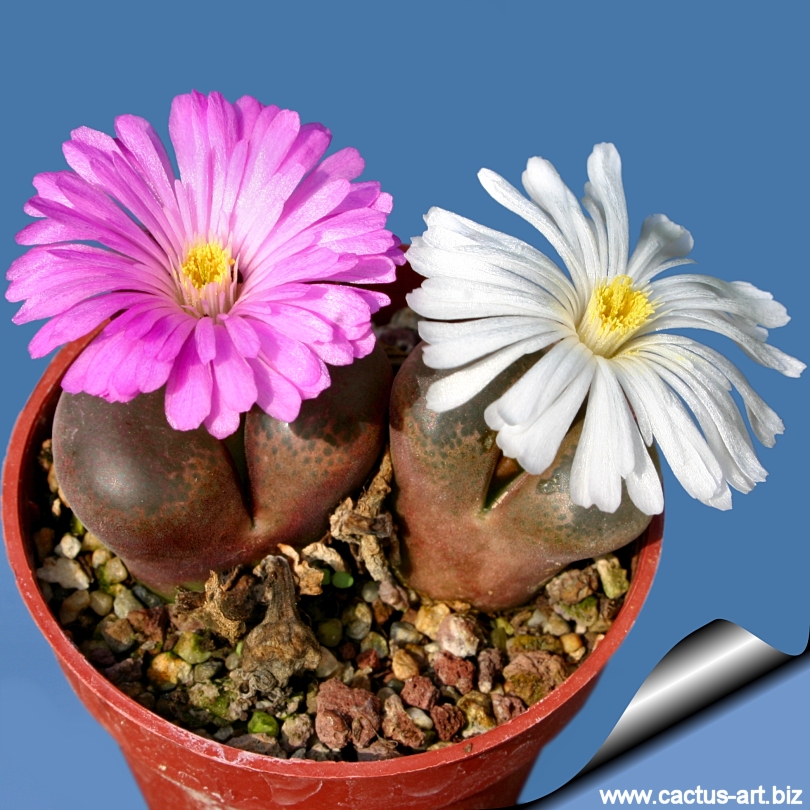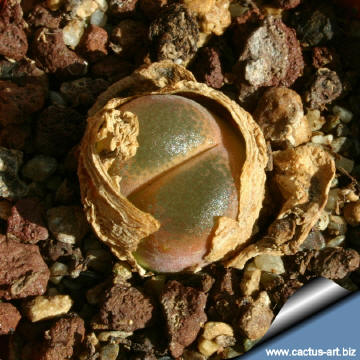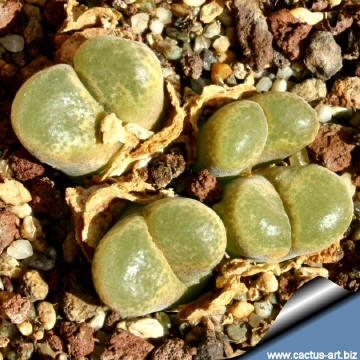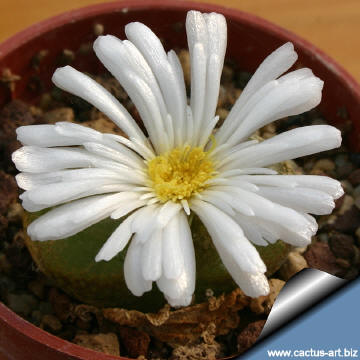|
|
|

Ophthalmophyllum friedrichiae (Conophytum)
This species has very handsome soft and shining body.
|
 |
 |
|
. |
 |
 |
|
. |
 |
 |
|
Photo of conspecific taxa, varieties, forms and
cultivars of Ophthalmophyllum (Conophytum) friedrichiae.
|
|


Advertising
|
|
|
|
|
Family:
Mesebrianthemaceae
(Aizoaceae)
Scientific name:
Ophthalmophyllum friedrichiae (Dinter) Dinter & Schwantes
Origin:
Northern Cape Province, Southern Namibia (Type locality: In the
vicinity of Warmbad)
Conservation status: Listed in
CITES appendix 2.
Synonyms:
-
Mesembryanthemum friedrichiae Dinter (1914)
-
Conophytum friedrichiae (Dinter) Schwantes (1928)
-
Conophytum renominatum Rowley (1978)
-
Conophytum schwantesii Rowley (1978)
-
Ophthalmophyllum triebneri Schwantes (1934)
-
Ophthalmophyllum vanheerdii L.Bolus (1962)
|
Description: Tiny groundcover succulent that forms mounds of
purple or green grapes.
This species is however very variable in shape and colour.
Body: 2-3 cm wide, soft to the touch, reddish-brown (usually), purple or almost
pure aquamarine-green, translucent and shining.
Flowers: Usually pinkish but also reddish mauve or pure white, up
to 3 cm in diameter.
Conophytum/Ophtalmophyllum:
These plants forms a group within the large genus
Conophytum
and for a long time they was considered a separate genus,
Ophthalmophyllum. Generally the Ophthalmophyllums look like they
are formed from glass, ranging in colour from coke-bottle green to
brown, to quite reddish. Some of these plants remain solitary, others
clump quite readily; some are touchy in cultivation, some grow easily.
They all resemble each other and are easy to recognize as a group. They
include species such as
C. friedrichiae,
C. limpidum, the slightly fuzzy C. pubescens, and the
clump forming C. praesectum.
|
|
|
|


Leaves are fenestrate and
translucent.
Cultivation: It is relatively easy to grow. These plants
grow on winter rain and head for summer dormancy. The
growing season in northern hemisphere is from September to March.
They require little water; otherwise its epidermis breaks (resulting in
unsightly scars). Water minimally in summer, (only occasional
misting when the plant starts shrivelling), but it
will generally grow even in summer if given water. Water regularly in
winter after the previous year's leaves have dried up. Requires good
drainage. It enjoy
some shade (avoid direct sun as it grows wild among rocks and under the
shade of other plants) and in summer it need to be kept in a cool area.
Hardy to -2°C.
Ensure a very good ventilation. Avoid to repot frequently. This plant
may stay in the same pot for many years. Plants grown in larger
containers have frequently relatively poor flowers. It might improve
when the plants are given their own, small individual pots.
Propagation: It can be
reproduced both by cuttings and seeds. Take the cutting from a grown-up
mother plant. Each
cutting must contain one or more heads along with
a fraction of root. |
|